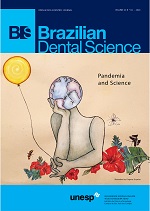Nanostructured platelet-rich plasma: state of art in dental treatments
DOI:
https://doi.org/10.14295/bds.2020.v23i2.1838Abstract
Objectives: Reviewing information available about platelet-rich plasma (PRP) applied to dental treatments, introducing the general concept of PRP, as well as analyzing actual data about, and challenges faced by, the dental field. Data & sources: The current study analyzed the most informative publications about PRP application available in this field and gathered the maximum information about it as possible. Conclusions: PRP use, either alone or in association with other biomaterials, can significantly favor different fields such as tissue engineering, since it is an innovative technique that attracts the interest of clinicians and basic scientists. However, it is necessary conducting better designed and controlled experiments to enable successful tissue healing based on PRP use. Clinical significance: The current review can be used by clinicians as source of information about the actual rules and protocols adopted in the herein addressed field, besides providing specific examples of such applications.
Keywords
Platelet-rich plasma; Dental treatment; Plateletgrowth factors; Nanotechnology; Bone regeneration; Surgery.
Downloads
Downloads
Additional Files
Published
How to Cite
Issue
Section
License
Brazilian Dental Science uses the Creative Commons (CC-BY 4.0) license, thus preserving the integrity of articles in an open access environment. The journal allows the author to retain publishing rights without restrictions.
=================




























